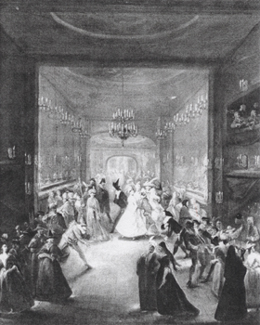

 Just
as there were contradictions embedded in masquerades, and a variety of opinions
about them held by society, there were many interpretations of masquerades
by authors in eighteenth-century fiction [1]. Some novelists
used the masquerades as a comic device to add plot twists and as an opportunity
to reveal something new about a character, while others used it as a ploy
on character to teach a moral lesson. One example of a comic scene is seen
in Babcock's "Liberty's a Whore" when "a male painter dressed as a woman is
forced to urinate among gentleman masqueraders" [2]. But
masquerades were more typically used as a device to pit a character against
social rebellion, or to test a character's virtue and chastity. Despite the
different perspectives authors took on masquerades, they were always associated
with social change. This was a common thread appearing in many eighteenth
century novels, and masquerades fit in quite easily. Tony Tanner explains
in his book, Adultery in the Novel, that the novel "dramatize[s] a larger
cultural conflict between moralistic and transgressive imperatives, equanimity
and adventure, the desire for bourgeois stability and the subversive human
fascination with change and novelty" [3]. Just as the masquerade
instigated social change and challenged the stability of social structure,
the novel did so as well. Thus it was natural that the novel would incorporate
the masquerade into itself. Masquerades brought the novel to a new level of
explicating social disruption. Characters could be faced with situations and
circumstances in a way that hadn't been done before. Therefore, masquerades
played a vital role in the transformation of the novel over the eighteenth
century.
Just
as there were contradictions embedded in masquerades, and a variety of opinions
about them held by society, there were many interpretations of masquerades
by authors in eighteenth-century fiction [1]. Some novelists
used the masquerades as a comic device to add plot twists and as an opportunity
to reveal something new about a character, while others used it as a ploy
on character to teach a moral lesson. One example of a comic scene is seen
in Babcock's "Liberty's a Whore" when "a male painter dressed as a woman is
forced to urinate among gentleman masqueraders" [2]. But
masquerades were more typically used as a device to pit a character against
social rebellion, or to test a character's virtue and chastity. Despite the
different perspectives authors took on masquerades, they were always associated
with social change. This was a common thread appearing in many eighteenth
century novels, and masquerades fit in quite easily. Tony Tanner explains
in his book, Adultery in the Novel, that the novel "dramatize[s] a larger
cultural conflict between moralistic and transgressive imperatives, equanimity
and adventure, the desire for bourgeois stability and the subversive human
fascination with change and novelty" [3]. Just as the masquerade
instigated social change and challenged the stability of social structure,
the novel did so as well. Thus it was natural that the novel would incorporate
the masquerade into itself. Masquerades brought the novel to a new level of
explicating social disruption. Characters could be faced with situations and
circumstances in a way that hadn't been done before. Therefore, masquerades
played a vital role in the transformation of the novel over the eighteenth
century.
Masquerades also provided an interesting plot device to add mystery or new perspective to the story. It was a place of intimacy where anything could take place. The masquerade was a useful vessel mimicking the notion of what makes a plot turn in a novel. Masquerades allowed for the "destabilization of the ordinary, a disequilibrium at the heart of things" [4]. They also opened up a way of celebrating ideas from the past that were regurgitated at the party scene. Terry Castle writes, "Just as the actual masquerade gave people in the increasingly secularized eighteenth century a way of acting out memories of the traditional world of magic and folk belief- as witches, conjurers, devils, and the like- so the masquerade set piece gave vestigial fantastic and marvelous literary element a paradoxical second life in realistic eighteenth century English fiction" [5].
Masquerades held many interesting functions in eighteenth century literature and paved the way for new methods of illustrating social change in this period. They were pivotal in the shaping and transformation of the novel and the purpose it came to serve in eighteenth-century culture.
Endnotes
1. Castle, Terry. Masquerade and Civilization:
the Carnivalesque in Eighteenth-Century
English Culture and Fiction. Stanford, CA: Stanford
University Press, 1986, 115.
2. Babcock, Barbara A. "Liberty's a Whore': Inversions, Marginalia,
and Picaresque Narrative."
In The Reversible World. Ed. Barbara A. Babacock.
Ithaca, NY, 1978, 96.
3. Tanner, Tony. Adultery in the Novel: Contract and Transgression.
Baltimore, 1979, 115.
4. Castle, 120.
5. Castle, 122.